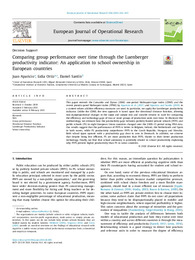Please use this identifier to cite or link to this item:
https://hdl.handle.net/11000/38282Full metadata record
| DC Field | Value | Language |
|---|---|---|
| dc.contributor.author | Aparicio Baeza, Juan | - |
| dc.contributor.author | Ortiz Henarejos, Lidia | - |
| dc.contributor.author | Santín González, Daniel | - |
| dc.contributor.other | Departamentos de la UMH::Estadística, Matemáticas e Informática | es_ES |
| dc.date.accessioned | 2025-11-18T11:53:54Z | - |
| dc.date.available | 2025-11-18T11:53:54Z | - |
| dc.date.created | 2021 | - |
| dc.identifier.citation | European Journal of Operational Research (EJOR) | es_ES |
| dc.identifier.issn | 1872-6860 | - |
| dc.identifier.issn | 0377-2217 | - |
| dc.identifier.uri | https://hdl.handle.net/11000/38282 | - |
| dc.description.abstract | This paper extends the Camanho and Dyson (2006) one-period Malmquist-type index (CDMI) and the recent pseudo-panel Malmquist index (PPMI) by Aparicio et al. (2017) and Aparicio and Santín (2018) to a context where additive efficiency measures are used. In particular, we apply the Luenberger productivity indicator. Unlike the CDMI, the new approach is based upon the directional distance function, allowing non-equiproportional changes in the input and output mix and variable returns to scale for comparing the efficiency and technology gaps of two or more groups of production units over time. To illustrate this methodology, we estimate how the productivity gaps between publicly funded private schools (PFPS) and public schools (PS) in eight European Union countries changed over the 2009–15 period using PISA data. Our results suggest that the performance of PFPS is better in Belgium, Ireland, the Netherlands and Spain in both waves, while PS productivity outperforms PFPS in the Czech Republic, Hungary and Slovakia. Both school types operate with a productivity gap close to zero in Denmark. In addition, we observe that despite being less efficient, PS are more productive than PFPS, thanks to their better production technology. Finally, we find that school autonomy is positively related to school productivity explaining why PFPS present higher productivity than PS in some countries. | es_ES |
| dc.format | application/pdf | es_ES |
| dc.format.extent | 22 | es_ES |
| dc.language.iso | eng | es_ES |
| dc.publisher | Elsevier | es_ES |
| dc.relation.ispartofseries | Vol. 294 | es_ES |
| dc.relation.ispartofseries | nº 2 | es_ES |
| dc.rights | info:eu-repo/semantics/openAccess | es_ES |
| dc.rights | Attribution-NonCommercial-NoDerivatives 4.0 Internacional | * |
| dc.rights.uri | http://creativecommons.org/licenses/by-nc-nd/4.0/ | * |
| dc.subject | DEA | es_ES |
| dc.subject | group performance | es_ES |
| dc.subject | directional distance function | es_ES |
| dc.subject | Luenberger productivity indicator | es_ES |
| dc.subject | school ownership | es_ES |
| dc.subject.other | CDU::5 - Ciencias puras y naturales::51 - Matemáticas | es_ES |
| dc.subject.other | CDU::5 - Ciencias puras y naturales::51 - Matemáticas::517 - Análisis | es_ES |
| dc.subject.other | CDU::3 - Ciencias sociales::31 - Demografía. Sociología. Estadística::311 - Estadística | es_ES |
| dc.title | Comparing group performance over time through the Luenberger productivity indicator: An application to school ownership in European countries | es_ES |
| dc.type | info:eu-repo/semantics/article | es_ES |
| dc.relation.publisherversion | https://doi.org/10.1016/j.ejor.2021.02.005 | es_ES |

View/Open:
2021-Comparing group performance over time through the Luenberger productivity indicator.pdf
1,77 MB
Adobe PDF
Share:
.png)
